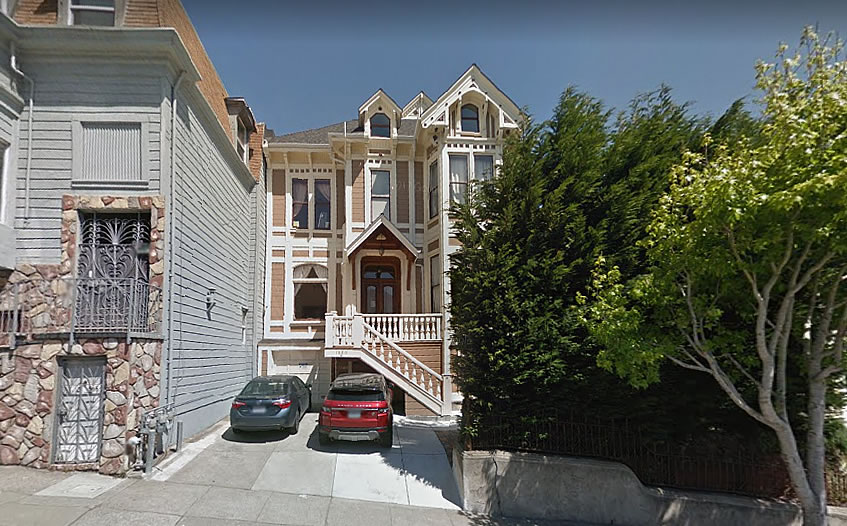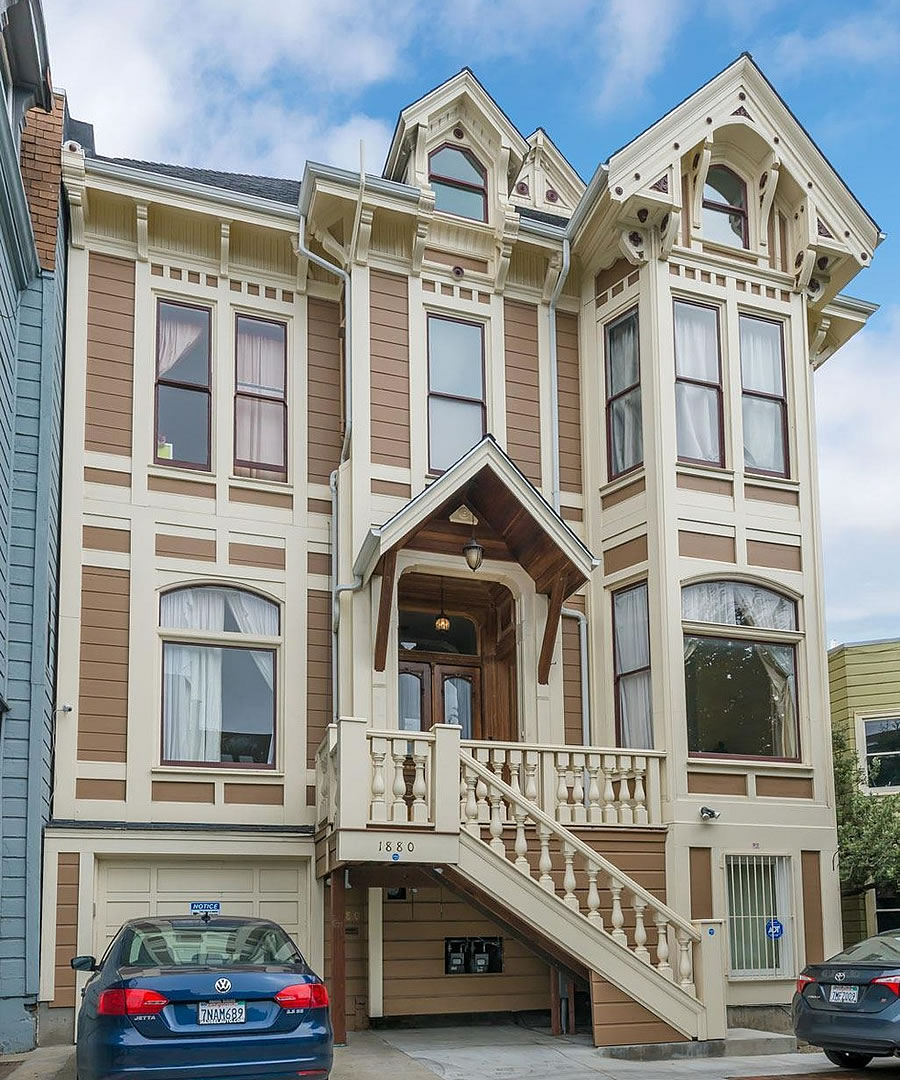Purchased by a venture capitalist for $3.98 million in August of 2015, the 7,500-square-foot Victorian at 1880 Turk Street has been serving as the headquarters and crash pad for a number of said VC’s startups, including the cryptocurrency company Bread(wallet).
Returned to the market listed for $4.8 million last march, a sale at which would have represented total appreciation of 20.6 percent, or roughly 12.6 percent per year, for the 9-bedroom “Victorian mansion like no other,” with the “potential to add [even] more bedrooms,” the list price for the mansion was reduced eight times over the past year.
And with a price which was changed to $3.95 million this past January, the sale of 1880 Turk Street has now closed escrow with an “over asking” contract price of $4.0 million, representing total appreciation of $20,000 (0.5 percent) for the property on an apples-to-apples basis since the third quarter of 2015.










With staging like that, it should be sold for a loss. $20K difference between purchase and sales price is a loss.
What the hell happened to that copper stove vent?
It looks like an unsuccessful effort to clean the tarnish off. “Why was there tarnish ?” you ask; probably for the same reason it looks like it was furnished w/ dorm castoffs: the people have many dollars to buy a house but no sense – pun intended – in how to take care of it.
What is with this painting each room a different color business? Sheesh.
This is a perfect example of how “start-up people” live:
Like they’re at a kindergarten day care center.
Maybe to them some other things matters more than “interior design.” That is how driven people are. Focus on things that are meaningful to them. What have you achieved to be so snooty?
Like the story the other month I read. A start up nerd was bemoaning the fact that he never saw his infant son and felt he was missing so many things. After all, the “ap” that allowed people to see what a couch looks like in their living room was so much more important than any mere meatspace thing like “life”.
Gawd. In the 19th century, our best and brightest built railroads or designed steel mills. Today’s geniuses design bits of code to make life even more convenient for the pampered 10%.
Exactly, well said.
To inthemarket: most, if not all apps are useless bits of data, designed NOT to make the planet and humans more healthy, safe and happy, but rather for these startup nerds to create some useless crap in hopes of selling it off to some other brainless startup nerd.
The “things that matter” to startups are of little value except money.
Yeah, man, Airbnb and Square and Dropbox aren’t changing the world at all.
19th century, how much of profits from those railroad and steel mills.
Did you ever manage to make 1% of people’s life more convenient? Fraction of a percent? Regardless less “pampered” or not?
Of course, achieve anything in life (unless everything is handed to you) requires sacrifices. Perhaps some people come to regret those sacrifices, but those are merely indicators those people had been working hard.
You (brian and futurist)…troll them (an entire class of people) because of their perceived living conditions or an article mentioning someone haven’t seen their son very much, does it really make you feel better?
Do you ever look at or use the useless apps that are floating out there? 1000’s of them.
And yea, I do feel better.
those useless apps remind me of mediocre kitchen and bath remodels designed by mediocre architects. so many materials that end up in land fills
“serving as the headquarters and crash pad for a number of startups”
Has no one on this thread worked at a startup? In order to maximize your investors’ dollars, you don’t spend your time or money on furnishings. You focus on measurable outcomes for the success of the company. I found the place surprisingly clean, bright and well organized, compared to the many start-ups I’ve seen. “vive la difference”
I eyed this building for a while. I’d kill for a floor plan. With some thoughtful wall, closet and bathroom creation, there’s a chance this could be made into a solid cash flow building framed as a co-op / community house. After mortgage (15k), taxes and insurance, let’s call it 20k month. 15 bedrooms at $1500 a month is 22,500. As a SFH, I believe there’s no rent control, correct? In years 10-30 you could be making a killing.
I’ll also add that there are likely better cap rate’s around. Clearly this project would be partially driven by entertainment / creating a cool community, not just $.
Oh great!
More of what SF needs: 20 somethings living like a 5 year old til they are 40 year olds, until they really grow up and live like adults.
Animal house for frat boys.
Well, they do say that SF is the only place in the country where you can be a college graduate with an advanced tech/medical degree and still live as if you were in college.
You should check out the NYT piece today about dorm living for adults. Apparently people are enjoying precisely this lifestyle (or rationalizing).
The backbone of SF – maitre d’s, teachers, bookstore managers, lounge musicians, copywriters and merchandise planners. Teachers I get but the rest – who did the research for this article?
Yes, great article in the NYT. My favorite quote came from one of the residents, who is 38 and just moved to SF even though she couldn’t afford to buy a house on $85k a year: “I want more meaning in my life”. I don’t want to be responsible again. I want to learn how to paint and make ramen noodles”.
There you have it. Adults with that amount of aspiration.
Brilliant.
The City certainly is not the only place in the country where you can be a college graduate and still live as if you were in college, but it sure is one of the cities where that circumstance for grown adults is commonly accepted. From the N.Y. Times over the weekend, Dorm Living for Professionals Comes to San Francisco:”In search of reasonable rent, the middle-class backbone of San Francisco &emdash;maitre d’s, teachers, bookstore managers, lounge musicians, copywriters and merchandise planners &emdash;are engaging in an unusual experiment in communal living: They are moving into dorms…shared bathrooms at the end of the hall and having no individual kitchen or living room is becoming less weird for some of the city’s workers thanks to…a new development company that is expressly creating dorms for many of the non-tech population.” Go read it, but realize that the author is confused about the difference between “middle-class” and (the modern) working class. Most of her interviewees are working class and perhaps just don’t realize it.
I’m sure ss covered the buildings described in the piece when they were proposed but I couldn’t find the relevant post for the two Tenderloin properties it mentions.
Or as we first penned four years ago when the trend was emerging: Dorms For Developers In San Francisco?
What SF needs: bedrooms. This provides that. We need to stop being so prescriptive with how people are “supposed” to live, and start providing bedrooms.
Yeah Futurist, you kinda made that point earlier in the thread. For a guy who derides others for their “armchair criticisms”, you seem to have a problem keeping your trap shut about this place.
A $4 million house that needs $1 million in renovations to make it work as a house. What a steal!
One question that is unanswered here is whether or not any of the ventures incubated in this otherwise “meh” large house panned out for the venture owner. I think it is entirely possible we will see more and more housing-as-compensation or housing-as-benefit jobs.
If the owner hosted 10 startup idea crews and one or two paid off 10X or 40X, one could make a strong argument that the house investment as a package deal was entirely worthwhile.
That’s one of the reasons I started my incubator house in Palo Alto after I sold Aviato. Without it, I couldn’t have met Richard, Big Head, or Gilfoyle. I can smoke a case of shiller for how things have panned out in the meantime.
Nice palapa.
I’m so impressed. Are you finding a cure for cancer or AIDS, or solving hunger in Africa? Didn’t think so.
We all know you’re on the Hooli payroll, Futurist. Like Pied Piper never made a difference in your life.
soccermom scores again. genius
These coliving spaces are temporary trends, they won’t last. They fit with the ethos of the times, coupled by very high rents in the city. Also coworking spaces, while having a better case for longevity, are being over played. Trends, trends, silly trends…always overplayed by the fast buck seeking crowd…
Those SRO’s in the tenderloin have sure lasted a long time. They weren’t built as slums or eyesores.
I can’t believe they didn’t stage this with decent furniture.